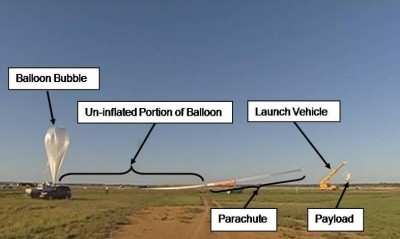Fri, Dec 17, 2010
Balloons Had Been Grounded Since An Accident In Australia In
April
NASA's scientific balloon program is resuming flights this month
after an extensive evaluation of its safety processes following a
mishap during an April launch attempt from Australia. NASA's
high-altitude balloons fly instruments for scientific and
technological investigations that contribute to our understanding
of Earth, the solar system, and the universe.

Balloon Launch Configuration From Final Report
In October, a NASA mishap review board listed 25 causes that
contributed to the accident, including insufficient risk analysis,
contingency planning, personnel training, government oversight and
public safety accommodations."NASA's Goddard Space Flight Center,
Wallops Flight Facility, and contractor balloon team have done an
outstanding job over the past eight months to develop and implement
plans to return the balloons to flight," said Jon Morse, director
of the Astrophysics Division in the Science Mission Directorate at
NASA Headquarters in Washington. "We look forward to once again
conducting groundbreaking science with these balloon systems."
To prepare for the resumption of flights, NASA developed a
corrective action plan to address the recommendations from the
mishap review. To return to flight, NASA has:
- Developed a more stringent launch safety area in which the
balloon launch vehicle can maneuver in order to protect the safety
of the public.
- Revised the safety procedures used to conduct balloon
launches.
- Instituted NASA independent ground and flight safety roles to
ensure that balloon launches are conducted safely.
- Redesigned the launch head mechanism that failed to work
properly during the Australia aborted launch.
- Developed plans to better respond to mishaps and close calls
with respect to balloon launch operations.
NASA has approved flights that are scheduled throughout this
month over Antarctica. During the Antarctica flights, NASA will use
a vehicle that was specifically designed to launch the balloons
instead of a commercially obtained mobile crane, which was used
during the mishap in Australia. The launch vehicle is built to
handle the large, long-duration balloon (LDB) payloads on the
compacted snow launch surface. The LDB program in Antarctica is a
partnership between NASA and the National Science Foundation, and
is carried out through the U.S. Antarctic Program-- a continuous
national research presence on the continent since 1956 that is
managed by NSF.

NASA's scientific balloons are composed of a lightweight
polyethylene film, similar to sandwich wrap. Flying to altitudes of
nearly 25 miles, many of the balloons inflate to almost the size of
a football stadium and carry payloads weighing up to 6,000
pounds.
More News
Also: Netherlands Donates 18 F16s, 2 737s Collide On Ramp, E-7 Wedgetail Cut, AgEagle's 100th In S Korea The Pilot and Aircraft Privacy Act was introduced in the House by Represent>[...]
“This delivery represents more than just a milestone. It symbolizes our shared commitment to national security and our unwavering support for the men and women who serve on t>[...]
Aero Linx: Vintage Wings of Canada Foundation Vintage Wings of Canada is a not-for-profit, charitable organization with a collection of historically significant aircraft and is run>[...]
From 2023 (YouTube Edition): To Preserve and Teach Incorporated as a non-profit domestic corporation in June 1997, the Army Aviation Heritage Foundation (AAHF) is a one-of-a-kind, >[...]
Also: Air Taxis May Be Close, AgEagle Sells 100th, VAI Likes Bedford, AURA AERO Cleans Up Volocopter has resumed work towards the certification of its VoloCity eVTOL, this time und>[...]
 Airborne 06.30.25: US v ADS-B Misuse, Natl STOL Fire, Volocopter Resumes
Airborne 06.30.25: US v ADS-B Misuse, Natl STOL Fire, Volocopter Resumes Aero-News: Quote of the Day (07.06.25)
Aero-News: Quote of the Day (07.06.25) ANN's Daily Aero-Linx (07.06.25)
ANN's Daily Aero-Linx (07.06.25) Classic Aero-TV: Portrait of the Army Aviation Heritage Foundation
Classic Aero-TV: Portrait of the Army Aviation Heritage Foundation Airborne-NextGen 07.01.25: Volocopter Returns, B23 Energic, Iran Tech In UAVs?
Airborne-NextGen 07.01.25: Volocopter Returns, B23 Energic, Iran Tech In UAVs?




